Effect of Photocatalyst on Rheological Behavior and NO Degradation Capacity of Asphalt Binder
Abstract
:1. Introduction
2. Results and Discussion
2.1. FTIR Analysis
2.2. Rheological Behaviors Analysis
2.2.1. Frequency Sweep Analysis
2.2.2. MSCR Analysis
2.3. Fatigue Behaviors Analysis
2.3.1. Time Sweep Analysis
The 50% Modulus Reduction Criterion
Peak in S×N Criterion
2.3.2. LAS Analysis
2.4. NO Degradation Capacity Analysis
3. Materials and Experiments
3.1. Raw Materials
3.2. Preparation of Photocatalytic Asphalt
3.2.1. Aging Methods
3.2.2. FTIR
3.2.3. Frequency Sweep Test
3.2.4. MSCR Test
3.2.5. Time Sweep Test
3.2.6. LAS Test
3.2.7. NO Degradation Test
4. Conclusions
- (1)
- Oxidation of the lighter components to the heavier components acted as an important cause of aging and hardening of the asphalt binders. With 4 wt% nano-TiO2, TiO2-MA reduced 77.1% IS=O and 74.9% IC=O, presenting better aging resistance than C3N4-MA.
- (2)
- The proportions of viscoelastic components in photocatalytic asphalt binders were changed by the addition of g-C3N4, and nano-TiO2. TiO2-MA had more excellent rheological behaviors and rutting resistance than C3N4-MA.
- (3)
- TiO2-MA with 4 wt% nano-TiO2 displayed 14.1% Jnrdiff and 74.8% Rdiff, showing the lowest stress sensitivity compared to other dosages. TiO2-MA had superior creep recovery capability, which inhibited more non-reversible deformation compared to C3N4-MA.
- (4)
- Fatigue life of TiO2-MA with 4 wt% nano-TiO2 increased to 234.1% at 2.5% strain and 242.5% at 5% strain, respectively. TiO2-MA exhibited more fatigue resistance than C3N4-MA.
- (5)
- The NO degradation efficiencies of TiO2-MA and C3N4-MA improved with the increasing photocatalyst dosages. C3N4-MA with 5 wt% g-C3N4 achieved 17.8% NO degradation efficiency, behaving better than TiO2-MA.
Author Contributions
Funding
Data Availability Statement
Conflicts of Interest
References
- Guo, X.R.; Fu, L.W.; Ji, M.S.; Lang, J.L.; Chen, D.S.; Cheng, S.Y. Scenario analysis to vehicular emission reduction in Beijing-Tianjin-Hebei (BTH) region, China. Environ. Pollut. 2016, 216, 470–479. [Google Scholar] [CrossRef]
- Yin, C.Y.; Li, H.Y.; Cha, Y.Y.; Zhang, S.J.; Du, J.E.; Li, Z.H.; Ye, W. Characterizing in-cabin air quality and vehicular air filtering performance for passenger cars in China. Environ. Pollut. 2023, 318, 120884–120892. [Google Scholar] [CrossRef]
- Zhang, Z.N.; Zhao, J.C.; Man, H.Y.; Qi, L.J.; Yin, H.; Lv, Z.F.; Jiang, Y.H.; Dong, J.J.; Zeng, M.; Cai, Z.T.; et al. Updating emission inventories for vehicular organic gases: Indications from cold-start and temperature effects on advanced technology cars. Sci Total Environ. 2023, 882, 163544–163552. [Google Scholar] [CrossRef]
- Niu, X.; Chuang, H.C.; Wang, X.; Ho, S.S.H.; Li, L.; Qu, L.; Chow, J.C.; Watson, J.G.; Sun, J.; Lee, S.; et al. Cytotoxicity of PM2.5 vehicular emissions in the Shing Mun Tunnel, Hong Kong. Environ. Pollut. 2020, 263, 114386–114394. [Google Scholar] [CrossRef] [PubMed]
- Fu, Z.Q.; Wu, Y.M.; Zhao, S.; Bai, X.X.; Liu, S.H.; Zhao, H.Y.; Hao, Y.; Tian, H.Z. Emissions of multiple metals from vehicular brake linings wear in China, 1980–2020. Sci. Total Environ. 2023, 889, 164380–164410. [Google Scholar] [CrossRef]
- Paster, M.D.; Ahluwalia, R.K.; Berry, G.; Elgowainy, A.; Lasher, S.; McKenney, K.; Gardiner, M. Hydrogen storage technology options for fuel cell vehicles: Well-to-wheel costs, energy efficiencies, and greenhouse gas emissions. Int. J. Hydrogen Energy 2011, 36, 14534–14551. [Google Scholar] [CrossRef]
- Zhao, M.; Sun, T.; Feng, Q. Capital allocation efficiency, technological innovation and vehicle carbon emissions: Evidence from a panel threshold model of Chinese new energy vehicles enterprises. Sci. Total Environ. 2021, 784, 147104–147114. [Google Scholar] [CrossRef]
- Kumar, A.; Singh, H.; Kumari, G.; Bisht, S.; Malik, A.; Kumar, N.; Singh, M.; Raturi, A.; Barthwal, S.; Thakur, A.; et al. Adaptive resilience of roadside trees to vehicular emissions via leaf enzymatic, physiological, and anatomical trait modulations. Environ. Pollut. 2022, 313, 120191–120200. [Google Scholar] [CrossRef] [PubMed]
- Gohlke, D.; Kelly, J.; Stephens, T.; Wu, X.Y.; Zhou, Y. Mitigation of emissions and energy consumption due to light-duty vehicle size increases. Transp. Res. D Transp. Environ. 2023, 114, 103543–103554. [Google Scholar] [CrossRef]
- Jia, Z.Y.; Wei, N.; Yin, J.W.; Zhao, X.Y.; Wu, L.; Zhang, Y.J.; Peng, J.F.; Wang, T.; Yang, Z.W.; Zhang, Q.J.; et al. Energy saving and emission reduction effects from the application of green light optimized speed advisory on plug-in hybrid vehicle. J. Clean. Prod. 2023, 412, 137452–137460. [Google Scholar] [CrossRef]
- Yuan, D.D.; Jiang, W.; Sha, A.M.; Xiao, J.J.; Wu, W.J.; Wang, T. Technology method and functional characteristics of road thermoelectric generator system based on Seebeck effect. Appl. Energy 2023, 331, 120459–120479. [Google Scholar] [CrossRef]
- Dubsok, A.; Khamdahsag, P.; Kittipongvises, S. Life cycle environmental impact assessment of cyanate removal in mine tailings wastewater by nano-TiO2/FeCl3 photocatalysis. J. Clean. Prod. 2022, 366, 132928–132936. [Google Scholar] [CrossRef]
- Feng, X.T.; Gu, L.F.; Wang, N.Y.; Pu, Q.S.; Liu, G.L. Fe/N co-doped nano-TiO2 wrapped mesoporous carbon spheres for synergetically enhanced adsorption and photocatalysis. J. Mater. Sci. Technol. 2023, 135, 54–64. [Google Scholar] [CrossRef]
- Sun, Q.; Li, Z.J.; Li, J.M.; Liu, N.X.; Zhang, M.; Le, T. Advances in photocatalysis for mycotoxins elimination: Engineering strategies in photocatalyst designing, practical applications and future prospects. J. Alloys Compd. 2023, 955, 170234–170242. [Google Scholar] [CrossRef]
- He, H.Y.; Zhao, L.S.; Wei, L.G.; Wang, J.; Mao, W.; Liu, S.Y.; Deng, Y.H.; Zhan, Z.S.; Bai, H.H.; Liang, B.Y. Efficient degradation of Rhodamine B by coupling of Lys-CoFe-layered double hydroxide@graphitic-C3N4 nanohybrids via photocatalysis under visible light. Mater. Lett. 2023, 343, 134405–134408. [Google Scholar] [CrossRef]
- Lu, N.; Cai, J.Z.; Niu, B.L.; Zhou, Y.; Zhao, G.H. Preferential removal of phthalic esters by photocatalysis on selective TiO2. Chem. Eng. J. 2023, 460, 141735–141745. [Google Scholar] [CrossRef]
- Wang, H.H.; Yu, S.W.; Gao, T.; Tan, X.Y.; Meng, X.G.; Xiao, S.J. The efficient degradation of organic pollutants by Z-scheme MIL-88A@TiO2 heterojunction photo-Fenton catalyst: The synergistic effect of photocatalysis and Fenton catalysis. J. Alloys Compd. 2023, 960, 170688–170715. [Google Scholar] [CrossRef]
- Kim, Y.; Park, B. Photo-persistent effect-induced energy band bending at the TiO2/Ag nanoparticle surface plasmonic interface. Mater. Lett. 2022, 316, 132001–132004. [Google Scholar] [CrossRef]
- Yang, C.; Zhao, Z.Y.; Liu, Q.J. Regulating effect on photocatalytic water splitting performance of g-C3N4 via confinement of single atom Pt based on energy band engineering: A first principles investigation. Appl. Surf. Sci. 2022, 577, 151916–151926. [Google Scholar] [CrossRef]
- Bouteh, E.; Bentel, M.J.; Cates, E.L. Semiconductor-hydrophobic material interfaces as a new active site paradigm for photocatalytic degradation of perfluorocarboxylic acids. J. Hazard. Mater. 2023, 453, 131437–131443. [Google Scholar] [CrossRef]
- Ishak, N.; Jeyalakshmi, V.; Setka, M.; Grandcolas, M.; Devadas, B.; Šoóš, M. Upgrading of g-C3N4 semiconductor by a Nitrogen-doped carbon material: A photocatalytic degradation application. J. Environ. Chem. Eng. 2023, 11, 109381–109393. [Google Scholar] [CrossRef]
- Zhang, Z.; Liu, K.; Chong, D.; Niu, D.Y.; Lin, P.; Liu, X.Y.; Niu, Y.H.; Jing, R.X. Evaluation of photocatalytic micro-surfacing mixture: Road performance, vehicle exhaust gas degradation capacity and environmental impacts. Constr. Build. Mater. 2022, 345, 128367–128378. [Google Scholar] [CrossRef]
- Fan, W.; Chan, K.Y.; Zhang, C.X.; Leung, M.K.H. Advanced Solar Photocatalytic Asphalt for Removal of lity of Vehilcular NOx. Energy Procedia 2017, 143, 811–816. [Google Scholar] [CrossRef]
- Fan, W.G.; Chan, K.Y.; Zhang, C.X.; Zhang, K.; Ning, Z.; Leung, M.K.H. Solar photocatalytic asphalt for removal of vehicular NOx: A feasibility study. Appl. Energy 2018, 225, 535–541. [Google Scholar] [CrossRef]
- Yu, H.N.; Dai, W.; Qian, G.P.; Gong, X.B.; Zhou, D.Y.; Li, X.; Zhou, X.L. The NOx Degradation Performance of Nano-TiO2 Coating for Asphalt Pavement. Nanomaterials 2020, 10, 897. [Google Scholar] [CrossRef] [PubMed]
- Liu, W.; Wang, S.Y.; Zhang, J.; Fan, J.F. Photocatalytic degradation of vehicle exhausts on asphalt pavement by TiO2/rubber composite structure. Constr. Build. Mater. 2015, 81, 224–232. [Google Scholar] [CrossRef]
- Qian, G.P.; Zhu, X.; Yu, H.N.; Shi, C.Y.; Yao, D. The oil pollution and nitric oxide photocatalytic degradation evaluation of composite nanomaterials for asphalt pavement. Constr. Build. Mater. 2022, 314, 125497–125511. [Google Scholar] [CrossRef]
- Yang, Y.; Ji, T.; Su, W.Y.; Kang, Y.Q.; Wu, Y.H.; Zhang, Y.J. Enhanced washing resistance of photocatalytic exposed aggregate cementitious materials based on g-C3N4 nanosheets-recycled asphalt pavement aggregate composites. Constr. Build. Mater. 2019, 228, 116748–116758. [Google Scholar] [CrossRef]
- Huang, Y.; Zhang, J.; Wang, Z.Y.; Liu, Y.; Wang, P.G.; Cao, J.L.; Ho, W.K. g-C3N4/TiO2 Composite Film in the Fabrication of a Photocatalytic Air-Purifying Pavements. Sol. RRL 2020, 4, 2000170. [Google Scholar] [CrossRef]
- Hassan, M.; Mohammad, L.N.; Asadi, S.; Dylla, H.; Cooper, S. Sustainable Photocatalytic Asphalt Pavements for Mitigation of Nitrogen Oxide and Sulfur Dioxide Vehicle Emissions. J. Mater. Civ. Eng. 2013, 25, 365–371. [Google Scholar] [CrossRef]
- Da Costa Gomez, T.M.; Radtke, C.L.; Kalscheur, V.L.; Swain, C.A.; Scollay, M.C.; Edwards, R.B.; Santschi, E.M.; Markel, M.D.; Muir, P. Effect of focused and radial extracorporeal shock wave therapy on equine bone microdamage. J. Nano Electron. Phys. 2004, 33, 49–55. [Google Scholar] [CrossRef]
- Liao, M.J.; Liu, Z.H.; Gao, Y.L.; Liu, L.; Xiang, S.C. Study on UV aging resistance of nano-TiO2/montmorillonite/styrene-butadiene rubber composite modified asphalt based on rheological and microscopic properties. Constr. Build. Mater. 2021, 301, 124108–124117. [Google Scholar] [CrossRef]
- Yan, C.Q.; Yuan, L.X.; Yu, X.T.; Ji, S.Z.; Zhou, Z.F. Characterizing the fatigue resistance of multiple modified asphalts using time sweep test, LAS test and elastic recovery test. Constr. Build. Mater. 2022, 322, 125806–125814. [Google Scholar] [CrossRef]
- Neto, V.F.S.; Lucena, L.C.F.L.; de Barros, A.G.; Lucena, A.E.F.L.; Filho, P.G.T.M. Rheological evaluation of asphalt binder modified with zinc oxide nanoparticles. Case Stud. Constr. Mater. 2022, 17, e01224–e01234. [Google Scholar] [CrossRef]
- D1754/D1754M-20; Standard Test Method for Effects of Heat and Air on Asphaltic Materials (Thin-Film Oven Test). ASTM International: West Conshohocken, PA, USA, 2020.
- Rahimi, J.; Azizi, M.; Niksefat, M.; Heidari, M.; Naderi, M.; Maleki, A. An efficient superparamagnetic PEO-based nanocatalyst for selective oxidation of sulfides to sulfoxides. Inorg. Chem. Commun. 2023, 148, 110320–110327. [Google Scholar] [CrossRef]
- Mohamed, I.M.; Dao, V.D.; Yasin, A.S.; Mousa, H.M.; Mohamed, H.O.; Choi, H.S.; Hassan, K.M.; Barakat, N.A.M. Nitrogen-doped&SnO2-incoportaed TiO2 nanofibers as novel and effective photoanode for enhanced efficiency dye-sensitized solar cells. Chem. Eng. J. 2016, 304, 48–60. [Google Scholar]
- Saral, A.; Sudha, P.; Muthu, S.; Sevvanthi, S.; Irfan, A. Molecular structure spectroscopic Elucidation, IEFPCM solvation (UV–Vis, MEP, FMO, NBO, NLO), molecular docking and biological assessment studies of lepidine (4-Methylquinoline). J. Mol. Liq. 2022, 345, 118249. [Google Scholar] [CrossRef]
- Ling, M.; Luo, X.; Gu, F.; Lytton, R.L. Time-temperature-aging-depth shift functions for dynamic modulus master curves of asphalt mixtures. Constr. Build. Mater. 2017, 157, 943–951. [Google Scholar] [CrossRef]
- Vestena, P.M.; Schuster, S.L.; Almeida, P.O.B., Jr.; Faccin, C.; Specht, L.P.; Pereira, D.S. Dynamic modulus master curve construction of asphalt mixtures: Error analysis in different models and field scenarios. Constr. Build. Mater. 2021, 301, 124343–124356. [Google Scholar] [CrossRef]
- Gajewski, M.; Bańkowski, W.; Gajewska, B.; Sybilski, D.; Horodecka, R. Estimation of asphalt binders’ resistance to permanent deformation with application of the MSCR and multiple shear creep long recovery (MSCLR) tests. Constr. Build. Mater. 2021, 284, 122808–122820. [Google Scholar] [CrossRef]
- Wang, C.; Zhang, H.; Castorena, C.; Zhang, J.; Kim, Y.R. Identifying fatigue failure in asphalt binder time sweep tests. Constr. Build. Mater. 2016, 121, 535–546. [Google Scholar] [CrossRef]
- Chen, H.; Bahia, H.U. Modelling effects of aging on asphalt binder fatigue using complex modulus and the LAS test. Int. J. Fatigue 2021, 146, 106150–106159. [Google Scholar] [CrossRef]
- Wang, C.; Sun, Y.G.; Ren, Z.Y. Toward to a viscoelastic fatigue and fracture model for asphalt binder under cyclic loading. Int. J. Fatigue 2023, 168, 107479–107495. [Google Scholar] [CrossRef]
- Jin, J.; Xiao, T.; Tan, Y.Q.; Zheng, J.; Liu, R.H.; Qian, G.P.; Wei, H.; Zhang, J.H. Effects of TiO2 pillared montmorillonite nanocomposites on the properties of asphalt with exhaust catalytic capacity. J. Clean. Prod. 2018, 205, 339–349. [Google Scholar] [CrossRef]
- Lasne, J.; Lostier, A.; Salameh, T.; Athanasopoulou, E.; Karagiannis, D.; Kakouri, A.; Vassaux, S.; Lesueur, D.; Romanias, M.N. NOx emissions by real-world fresh and old asphalt mixtures: Impact of temperature, relative humidity, and UV-irradiation. Urban Clim. 2023, 49, 101457–101473. [Google Scholar] [CrossRef]
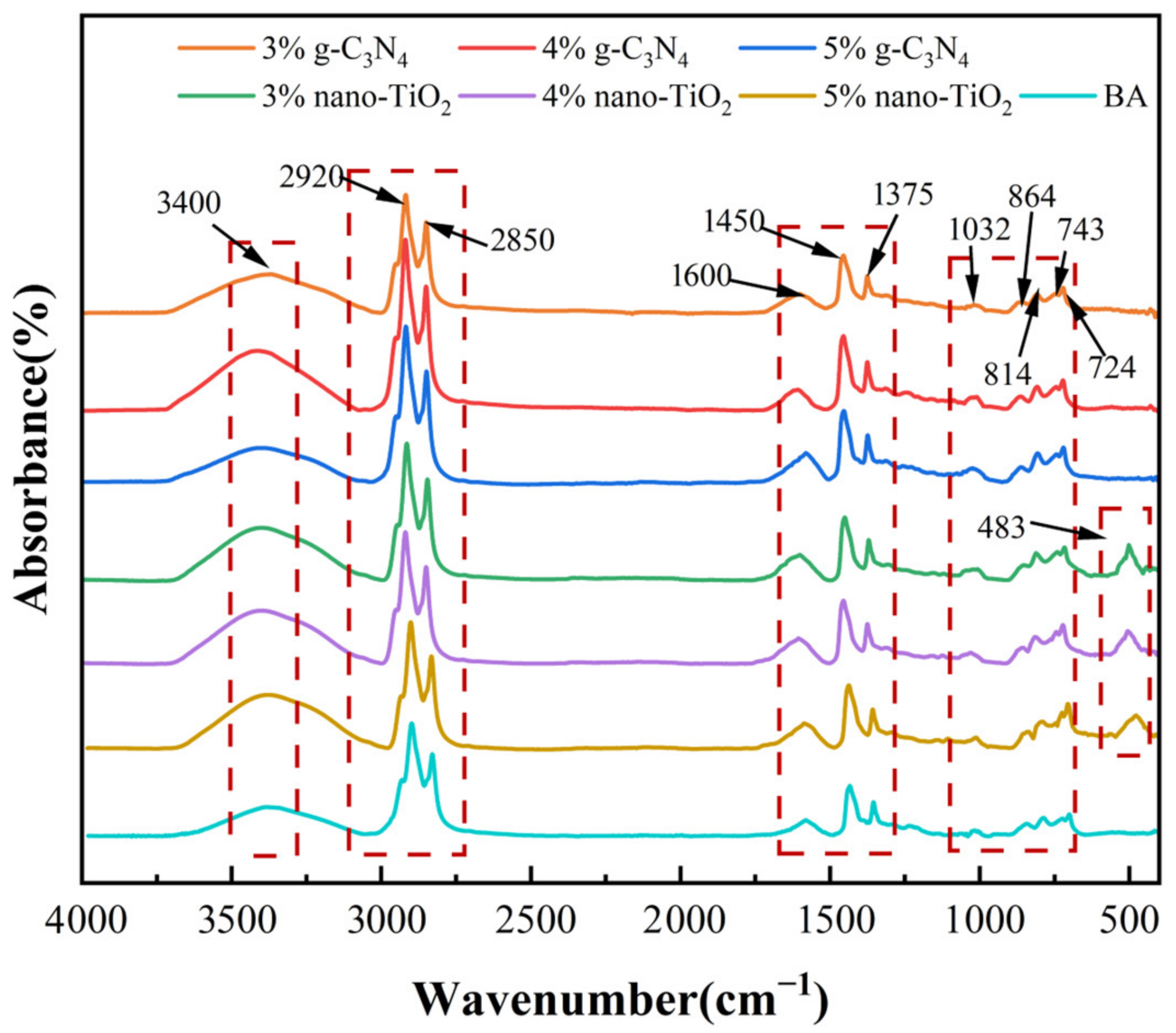
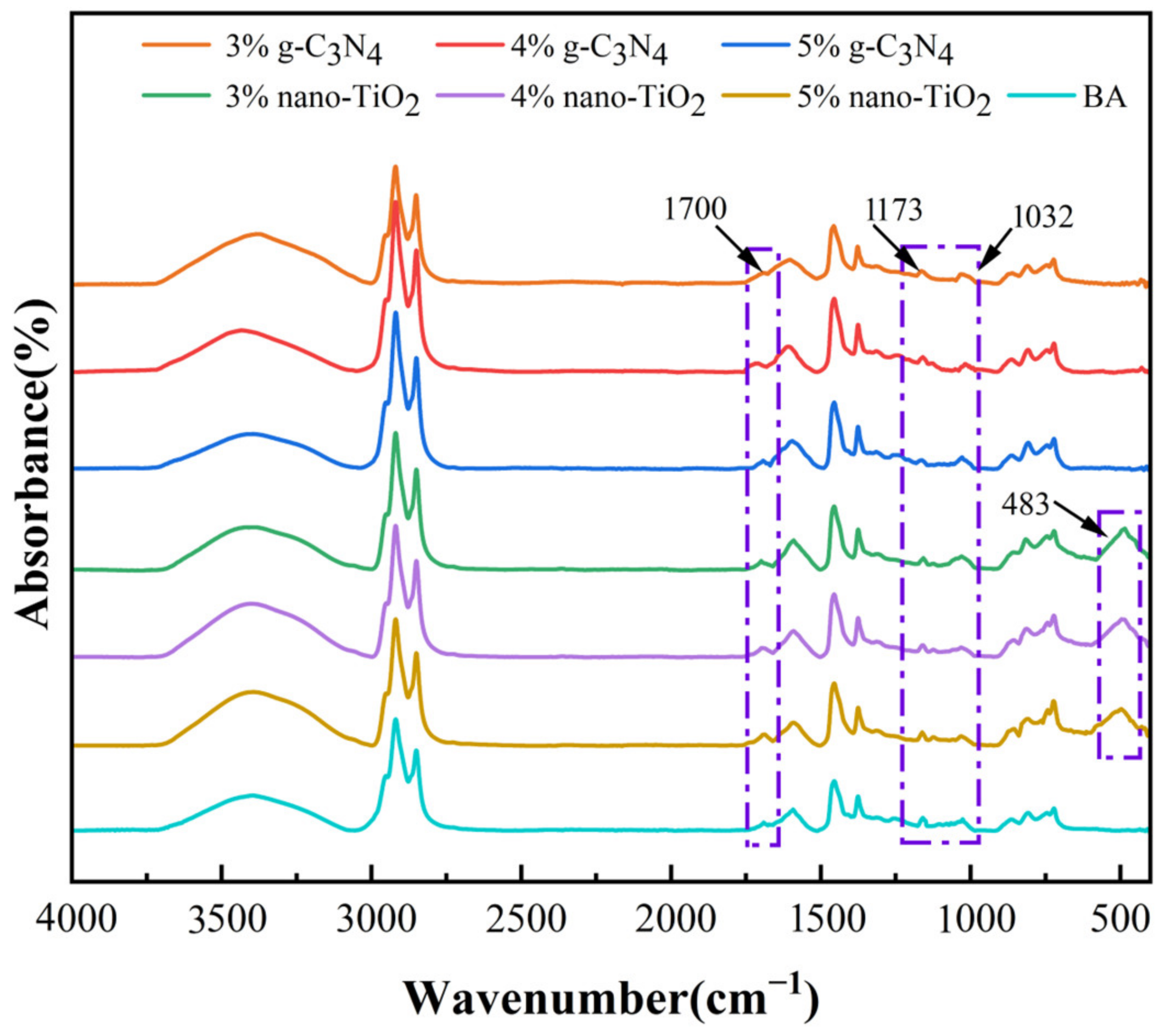
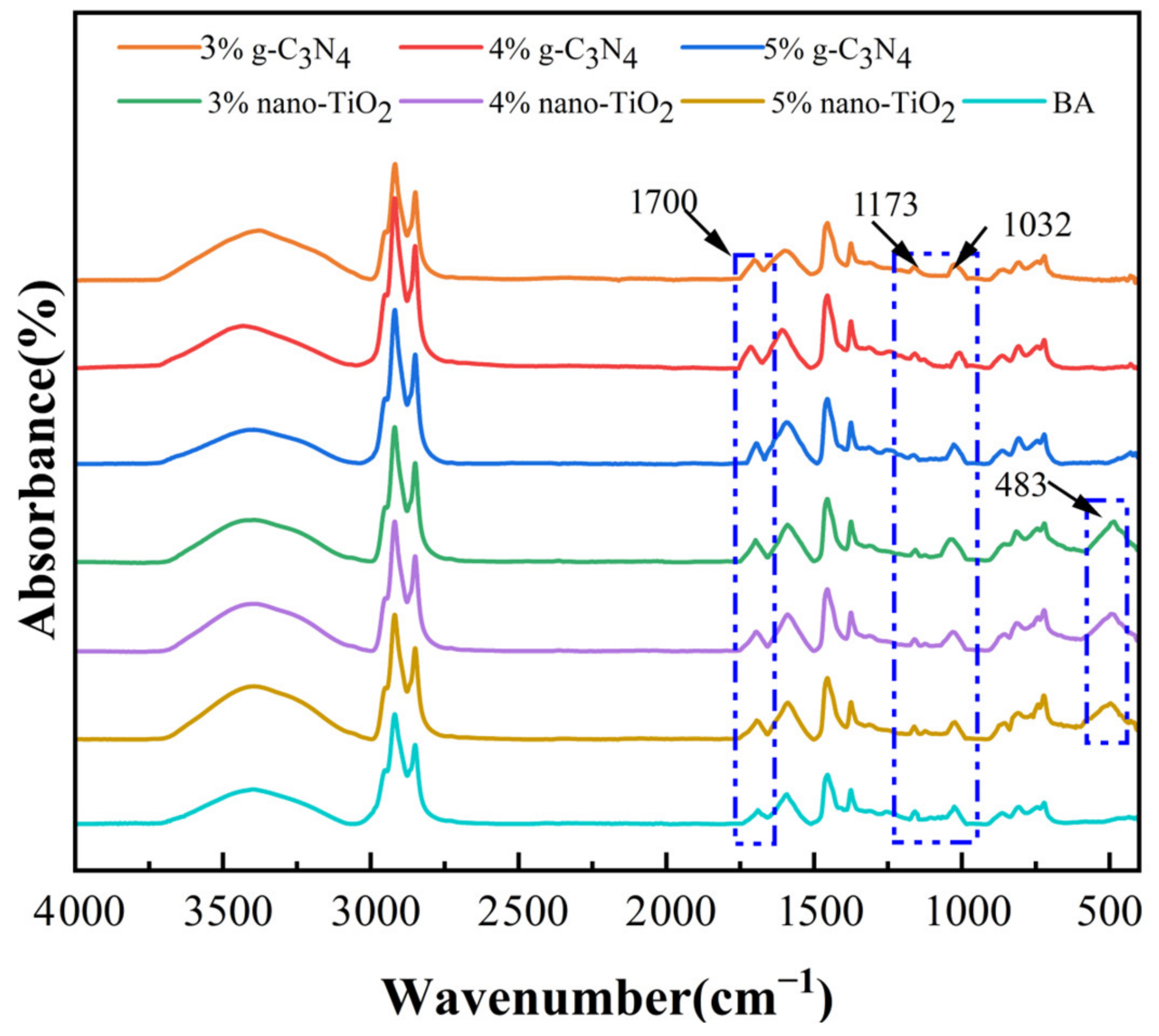

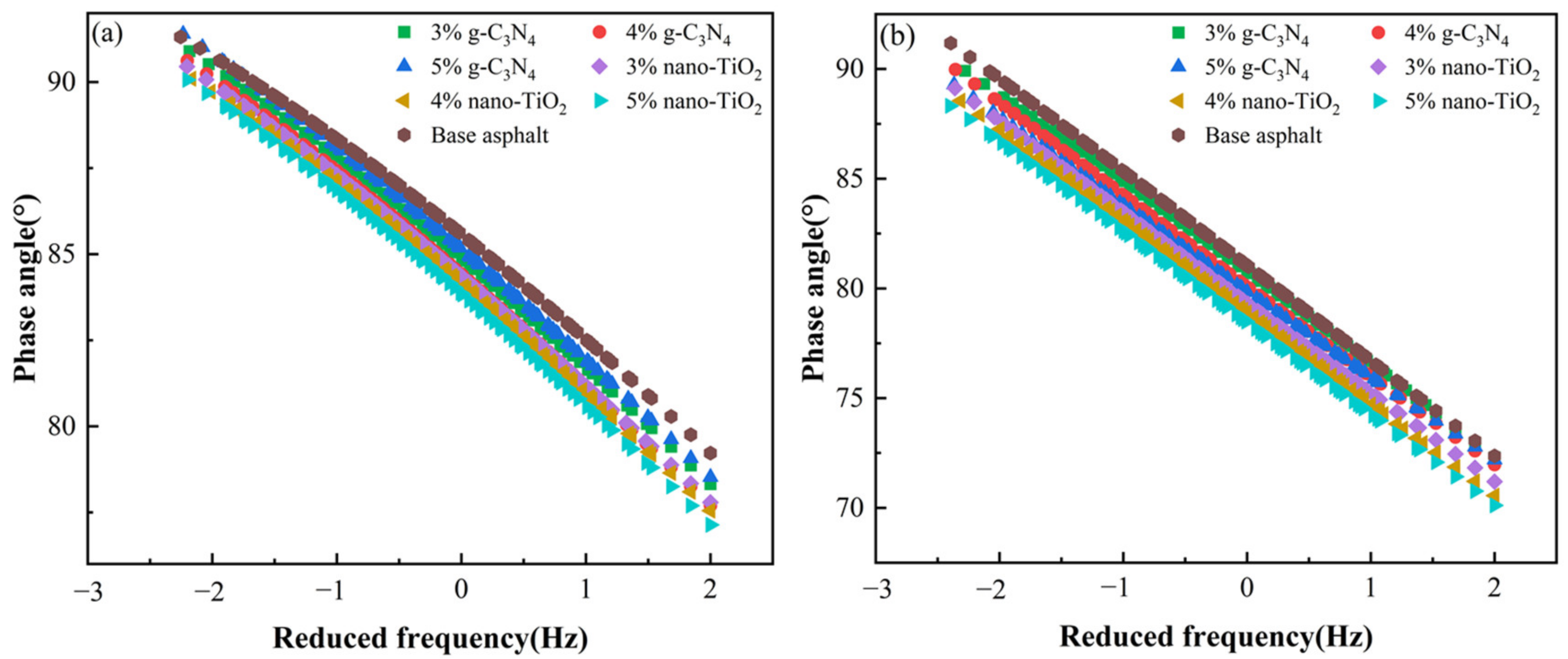
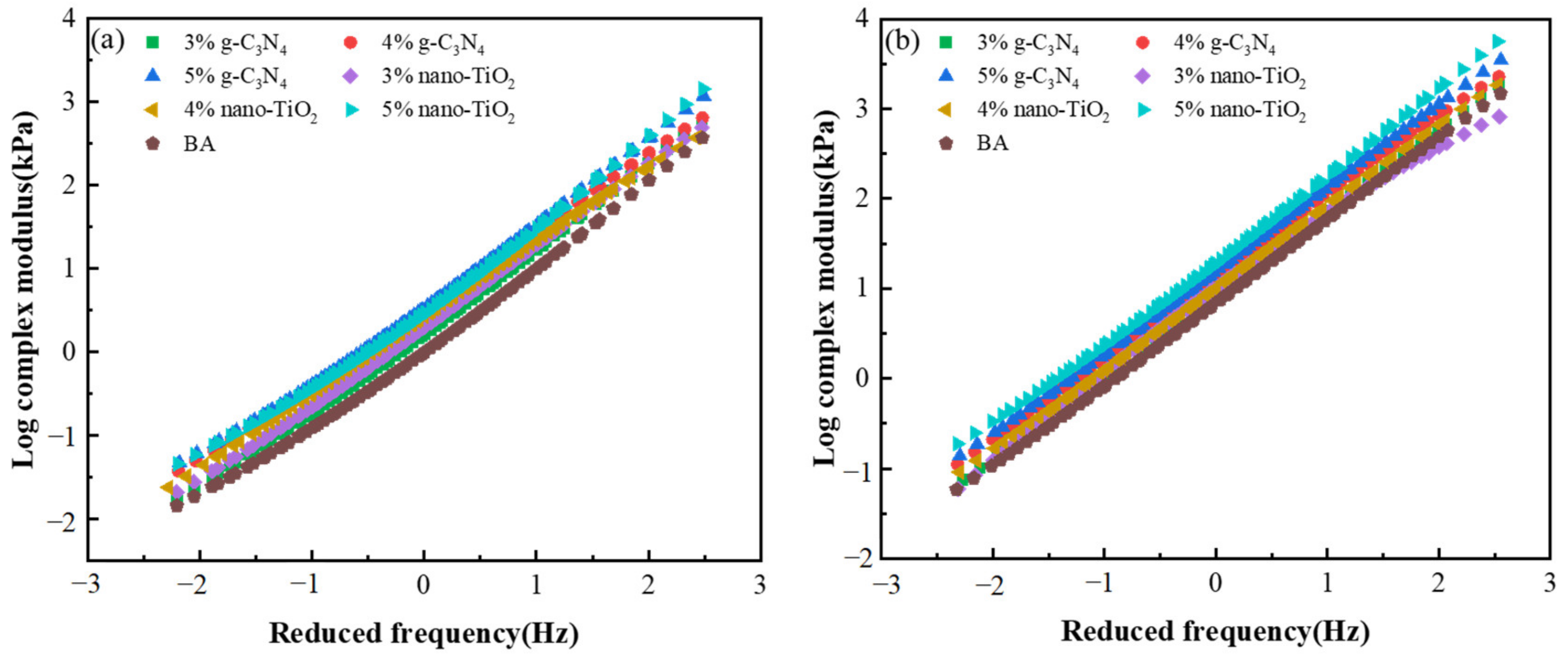
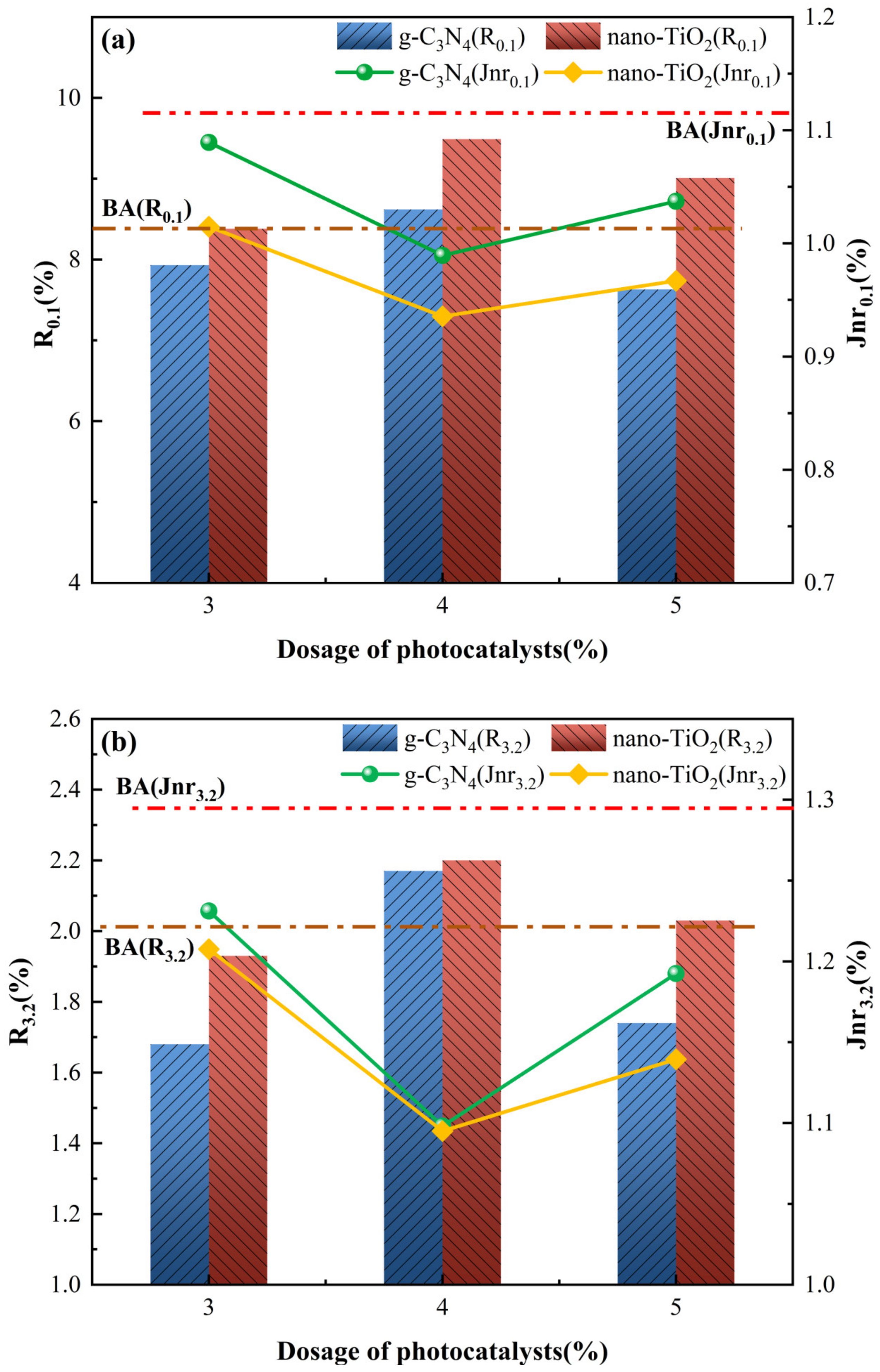



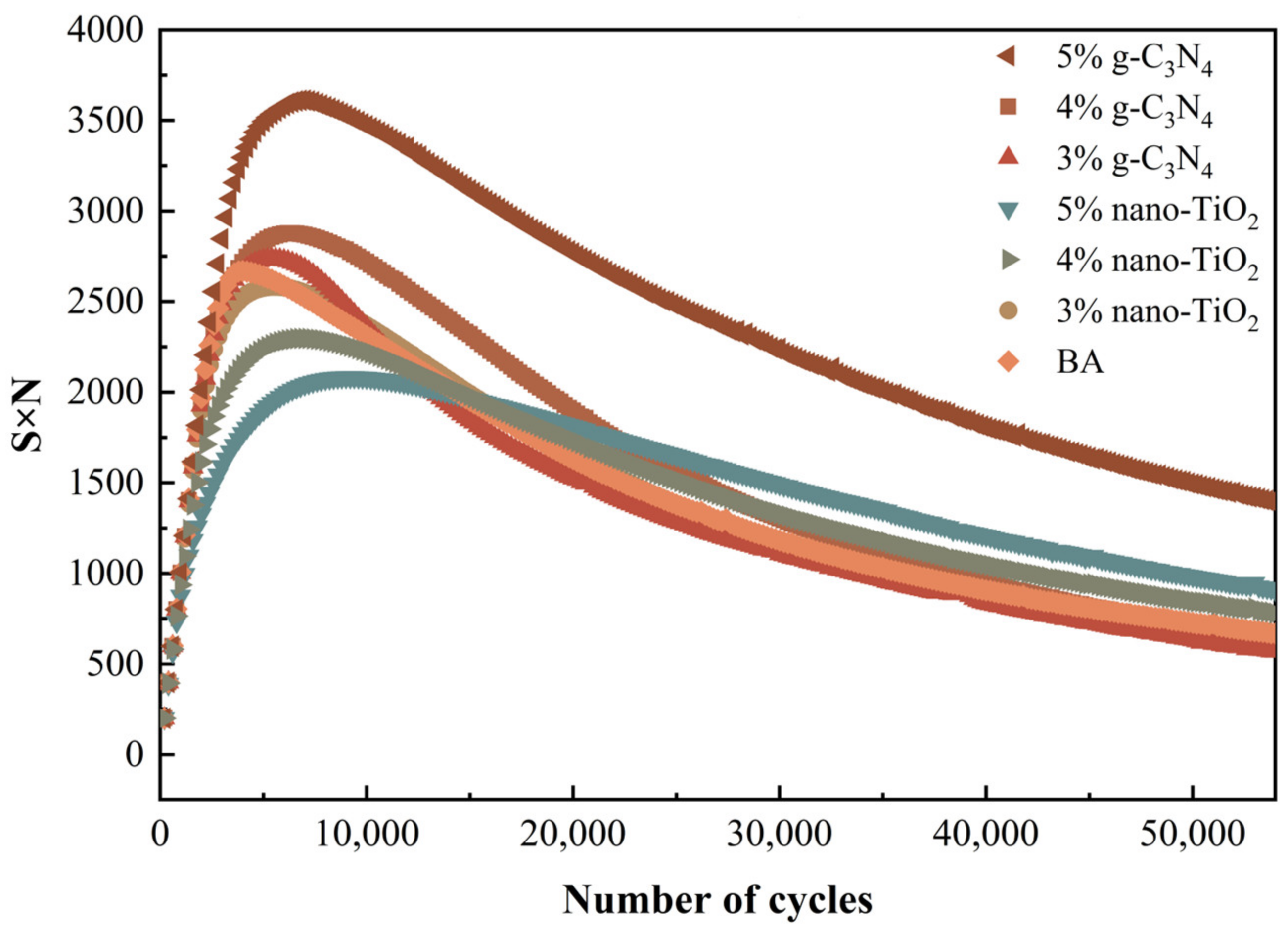
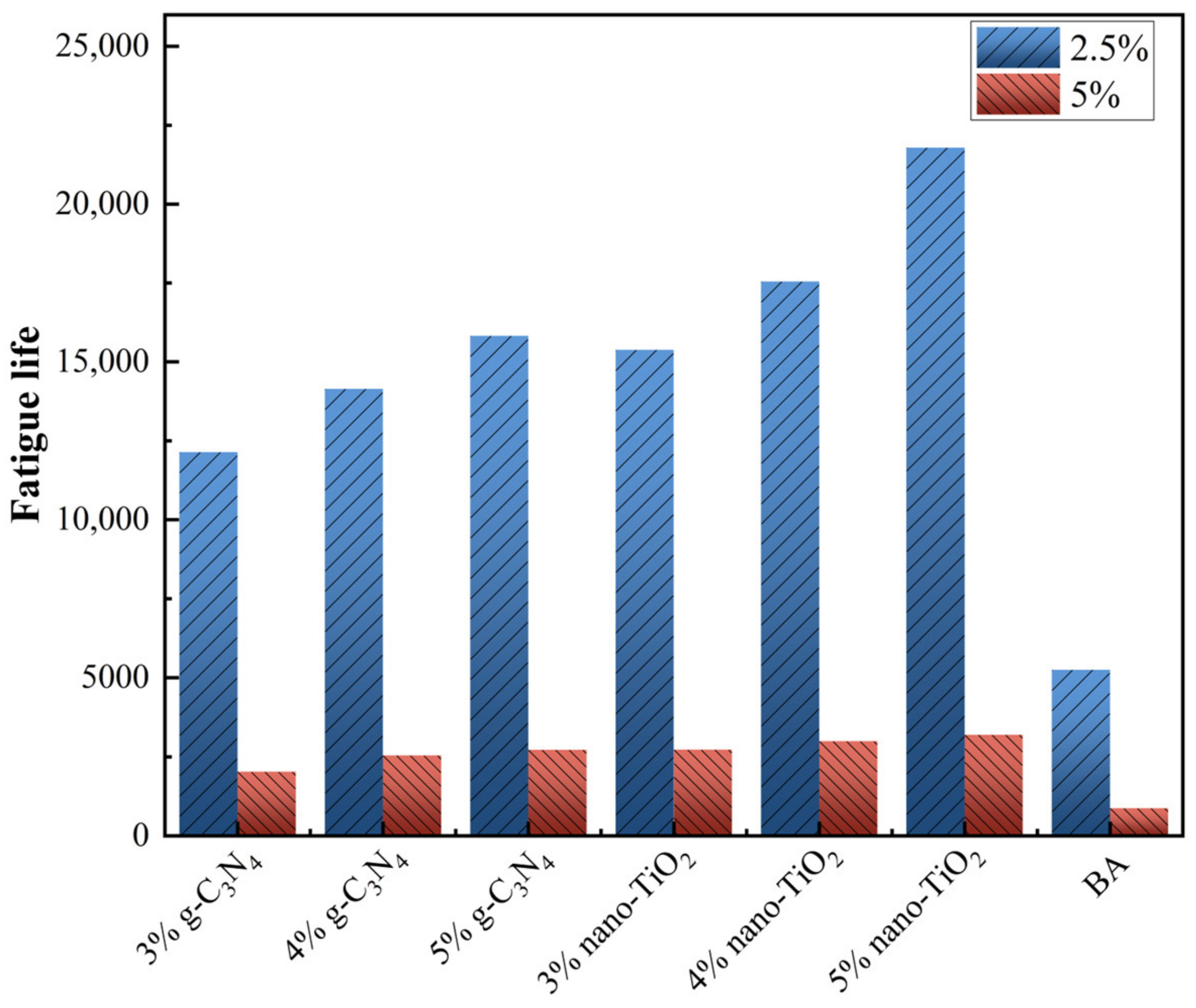
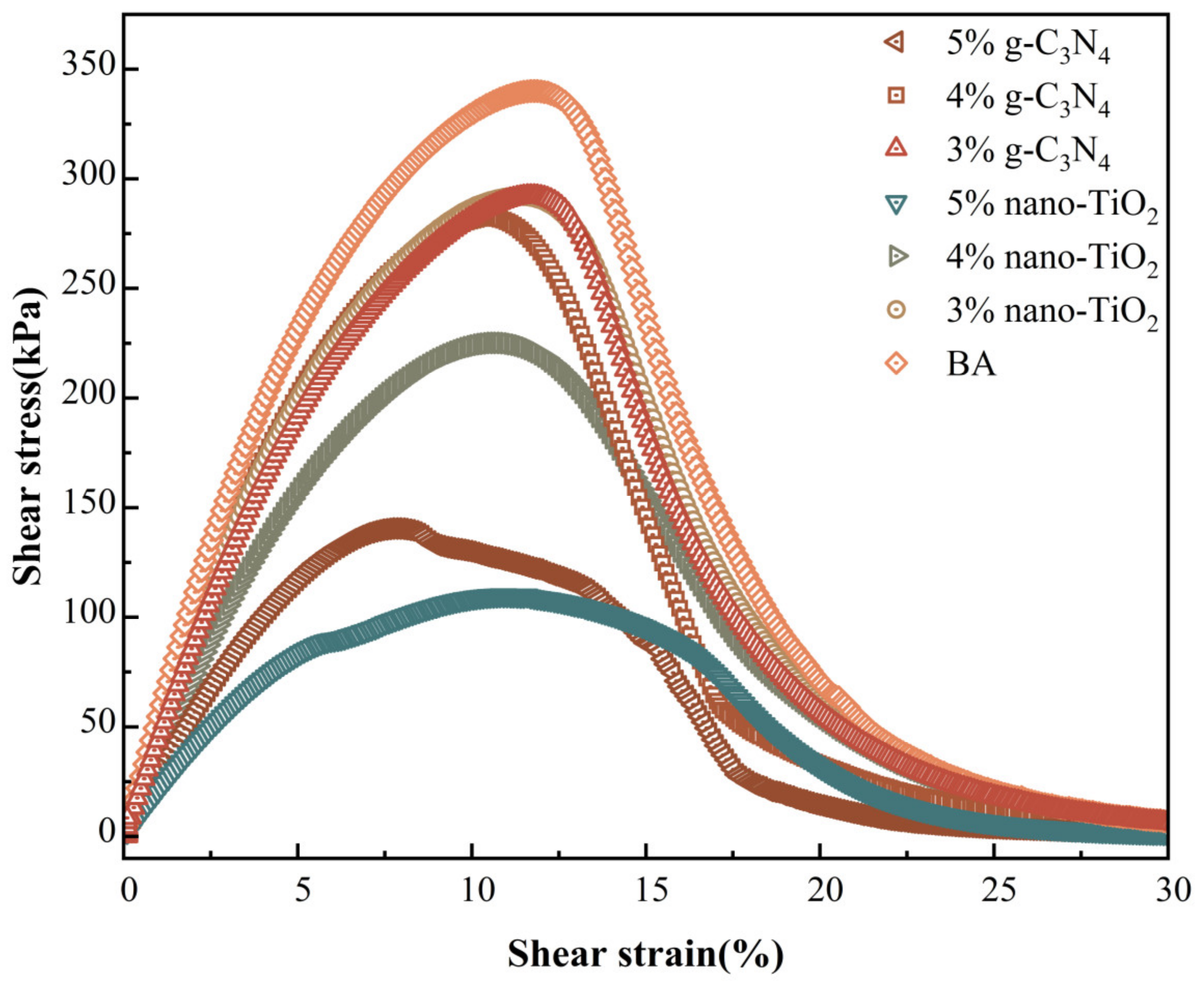
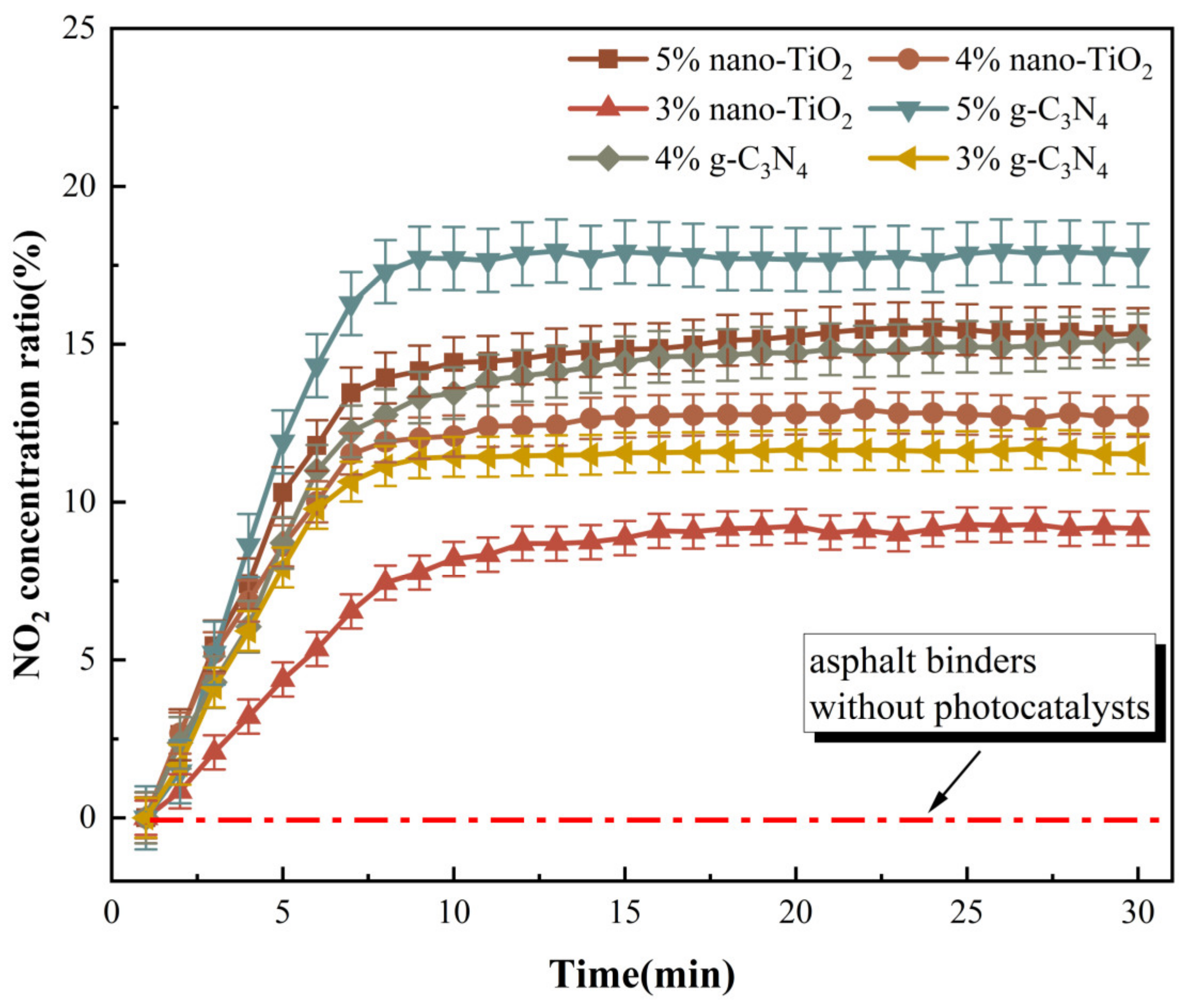


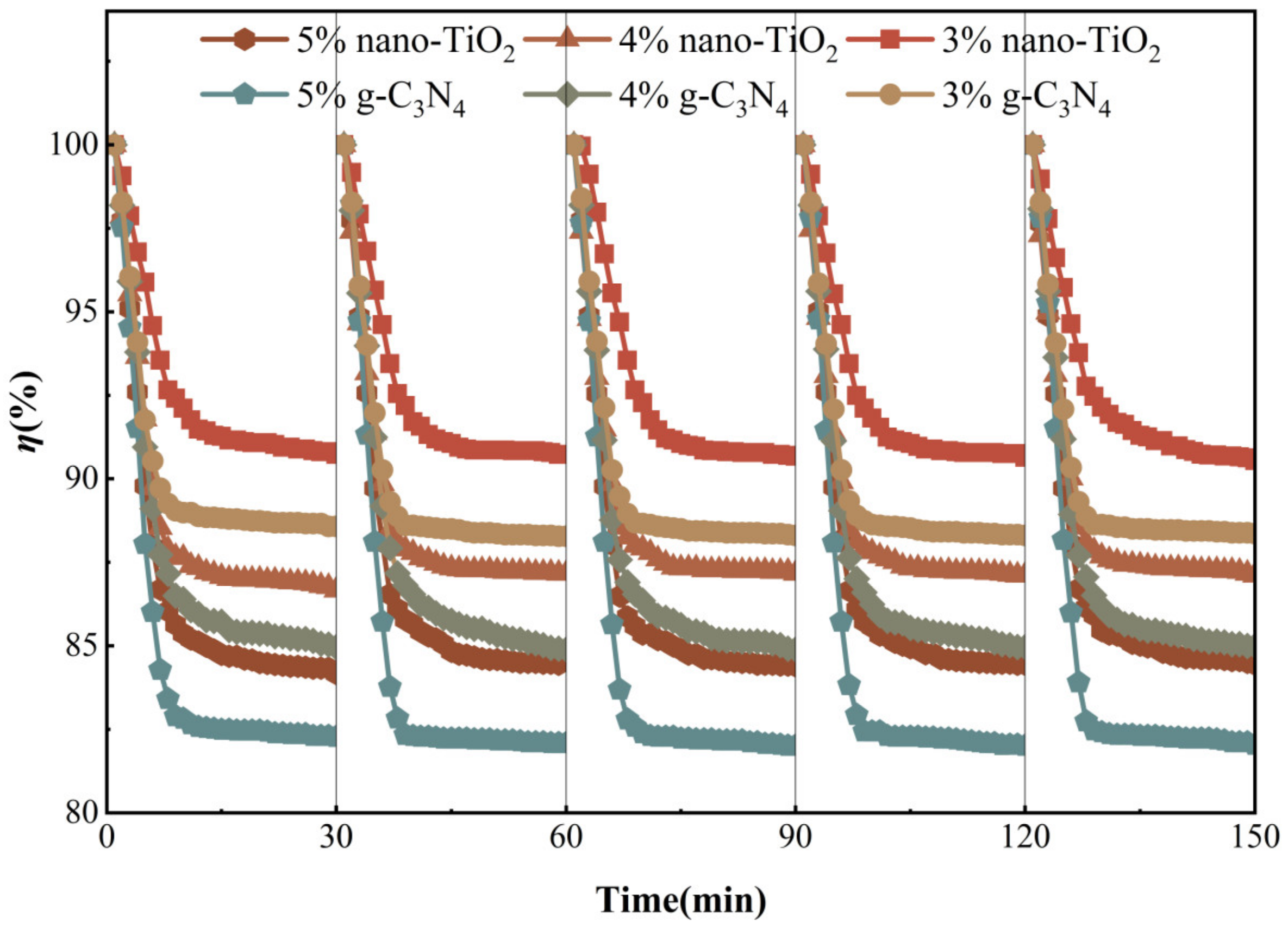

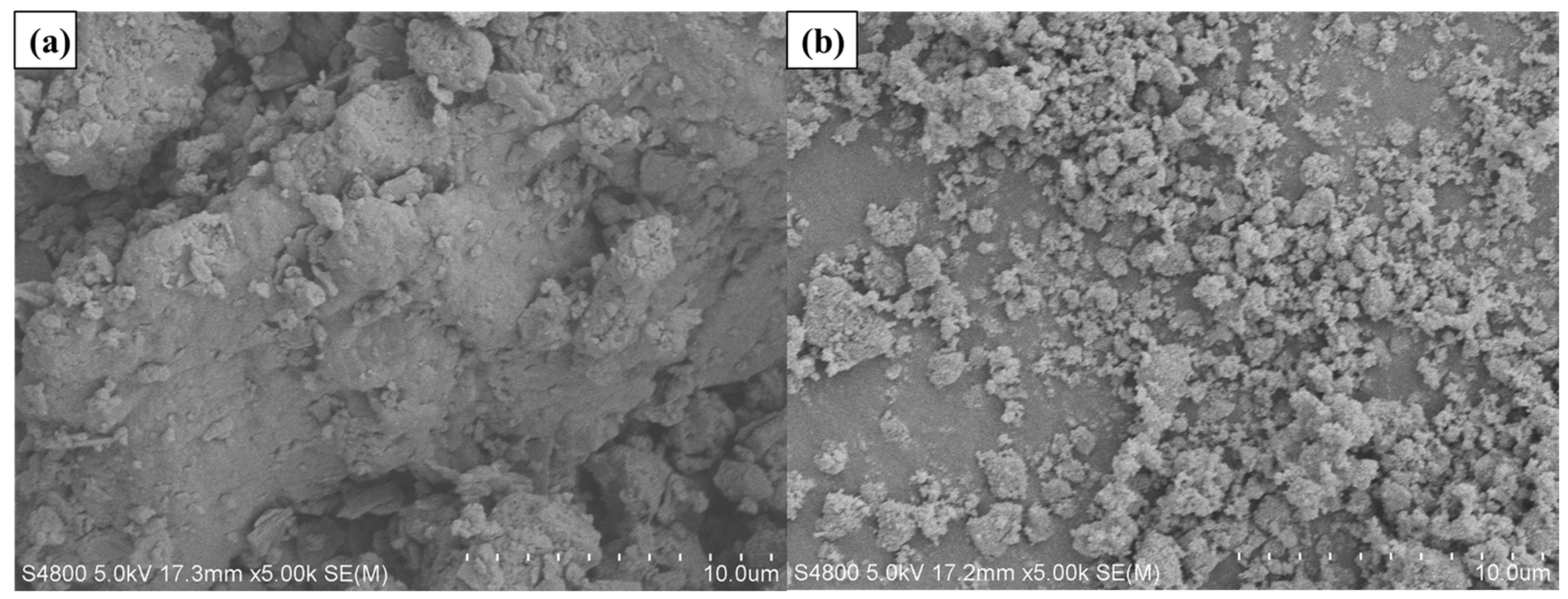
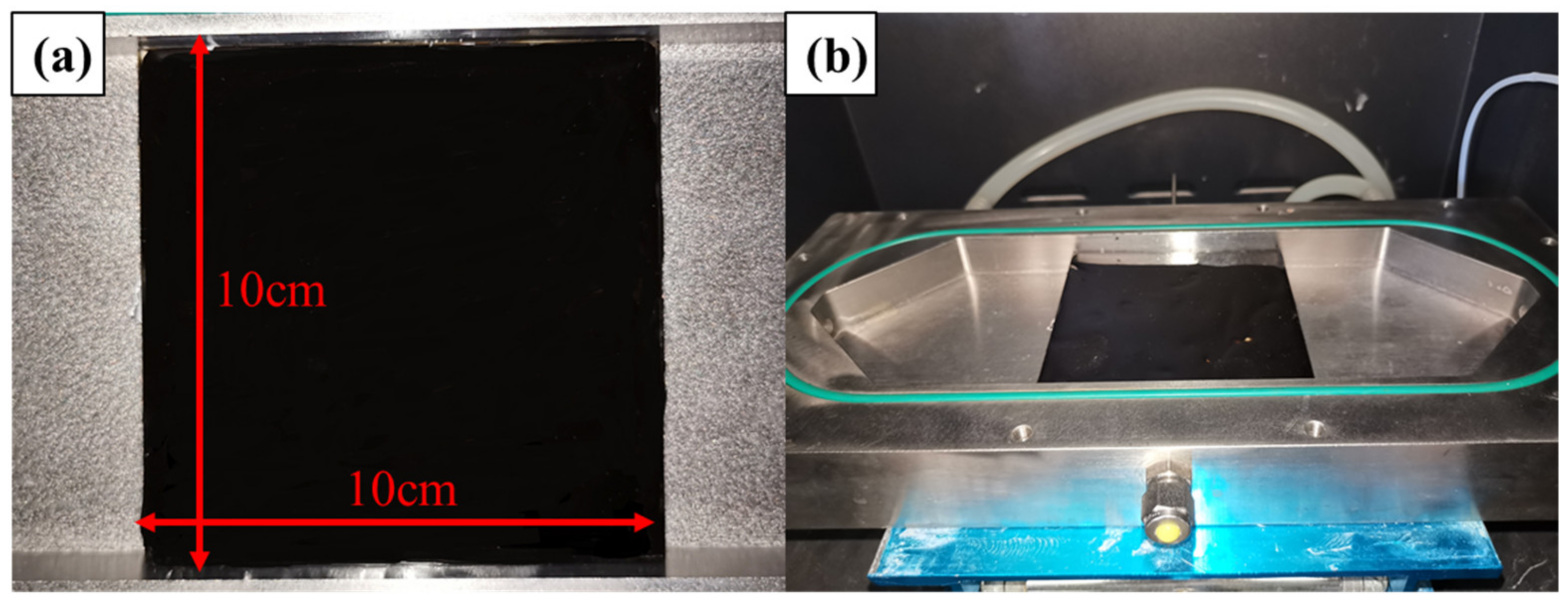

| Test Indicators | Measured Values | Technical Requirements | Testing Standards | |
|---|---|---|---|---|
| Penetration at 25°/mm | 67 | 60~80 | T 0604-2011 | |
| Softening point/°C | 52.5 | ≥46 | T 0606-2011 | |
| Ductility at 15 °C | >100 | ≥100 | T 0605-2011 | |
| Density at 15 °C/(g·cm−3) | 1.037 | Record of actual measurements | T 0603-2011 | |
| Viscosity at 135 °C/(Pa·s) | 2.608 | ≤3 | T 0619-2011 | |
| Thin film oven test (TFOT) | Quality loss/% | −0.504 | −0.8~0.8 | T 0610-2011 |
| Penetration ratio/% | 72 | ≥61 | T 0604-2011 | |
| Residual ductility at 15 °C/cm | 20 | ≥15 | T 0605-2011 | |
| Test Projects | Test Results | Standard Requirements |
|---|---|---|
| TiO2 content (%) | ≥99 | 98~99.5 |
| Grain size (nm) | 10~20 | ≤20 |
| Specific surface area (m2/g) | 80~220 | 80~110 |
| Packing density (g/cm3) | 0.24 | ≤0.5 |
| pH | 6.0~6.5 | 6.0~6.5 |
| Scorch weight reduction (%) | ≤1.0 | ≤3.5 |
| band gap value (eV) | 3.2 | - |
| Test Projects | Test Results | Standard Requirements |
|---|---|---|
| g-C3N4 content (%) | ≥99 | 98~99.5 |
| Specific surface area (m2/g) | 30 | - |
| Band gap (eV) | 2.7 | - |
| Specific gravity | 1.13 | - |
| Average particle size (μm) | 1.6 | - |
| pH (2% suspension) | 7 | Neutral |
Disclaimer/Publisher’s Note: The statements, opinions and data contained in all publications are solely those of the individual author(s) and contributor(s) and not of MDPI and/or the editor(s). MDPI and/or the editor(s) disclaim responsibility for any injury to people or property resulting from any ideas, methods, instructions or products referred to in the content. |
© 2023 by the authors. Licensee MDPI, Basel, Switzerland. This article is an open access article distributed under the terms and conditions of the Creative Commons Attribution (CC BY) license (https://creativecommons.org/licenses/by/4.0/).
Share and Cite
Wang, Y.; Wang, X.; Niu, D.; Niu, Y.; Xia, H.; Wang, Y. Effect of Photocatalyst on Rheological Behavior and NO Degradation Capacity of Asphalt Binder. Catalysts 2023, 13, 1083. https://doi.org/10.3390/catal13071083
Wang Y, Wang X, Niu D, Niu Y, Xia H, Wang Y. Effect of Photocatalyst on Rheological Behavior and NO Degradation Capacity of Asphalt Binder. Catalysts. 2023; 13(7):1083. https://doi.org/10.3390/catal13071083
Chicago/Turabian StyleWang, Yan, Xinyu Wang, Dongyu Niu, Yanhui Niu, Huiyun Xia, and Yue Wang. 2023. "Effect of Photocatalyst on Rheological Behavior and NO Degradation Capacity of Asphalt Binder" Catalysts 13, no. 7: 1083. https://doi.org/10.3390/catal13071083
APA StyleWang, Y., Wang, X., Niu, D., Niu, Y., Xia, H., & Wang, Y. (2023). Effect of Photocatalyst on Rheological Behavior and NO Degradation Capacity of Asphalt Binder. Catalysts, 13(7), 1083. https://doi.org/10.3390/catal13071083






